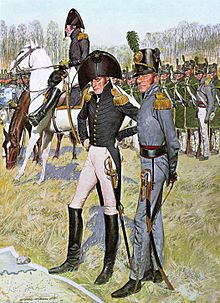Regiment of Riflemen (United States)
| Regiment of Riflemen | |
|---|---|

Riflemen officer in gray (foreground) and troops in green smocks (background)
|
|
| Active | 1808–21 |
| Country |
|
| Branch |
|
| Type | Riflemen |
| Role | Light infantry |
| Size | Regiment |
| Posts | New Orleans, Territory of Louisiana Washington, Mississippi Territory Fort Atkinson, Louisiana Purchase |
| Weapons |
Harpers Ferry Model 1803 U.S. Model 1814 scalping knife tomahawk, |
| Engagements | Tippecanoe York Fort George Big Sandy Creek |
| Campaigns |
Battle of Tippecanoe War of 1812 |
| Disbanded | March 2, 1821 |
| Commanders | |
| Commanders |
Alexander Smyth (1808-1812) Thomas Adams Smith (1812-1814, 1815-1818) George Washington Sevier(1814-1815) Talbot Chambers (1818-1821) |
| Key Subordinate Commanders | Benjamin Forsyth Daniel Appling Ludowick Morgan |
| Insignia | |
| Cap insignia authorized in 1817 |  |
The Regiment of Riflemen was a unit of the U.S. Army in the early nineteenth century. It was first activated in 1808. During the War of 1812, it was temporarily designated as the 1st Regiment of Riflemen when the War Department created three additional similar regiments. The regiment never fought as a unit. Companies, detachment from companies or collections of companies were stationed at a distance from each other and were often allocated to other commands. After the War, the other three regiments were inactivated and the regiment reverted to its unnumbered designation. The regiment was inactivated in June 1821.
Where can you find troops more efficient than Morgan's riflemen of the Revolution or Forsyth's riflemen of the last war with Great Britain?
On April 12, 1808, following the Chesapeake–Leopard Affair, the U.S. Congress passed legislation authorizing an increase in the size of the U.S. Army, to include a regiment of riflemen.
The headquarters of the regiment was authorized one colonel, one lieutenant colonel, one major, and administrative and support officers. The winter uniform of the regiment was green jackets with black collars and cuffs; the summer uniform was green hunting shirts and pantaloons with buff fringe. In 1814, uniform regulations specified gray cloth.
Companies were raised in various jurisdictions: three in New York and Vermont; three in the Louisiana and Mississippi Territories; and four in Ohio, Kentucky, and the Indiana Territory. Each company had an authorized strength of 84, including 68 privates; companies rarely attained their authorized strength. Regimental depots were placed in Shepherdstown, Virginia, and Savannah, Georgia.
On February 10, 1814, an act of Congress raised an additional three regiments of riflemen. The Regiment of Riflemen was subsequently redesignated as the 1st Regiment of Riflemen while the additional three were designated as the 2nd, 3rd and 4th regiments. Nevertheless, the four regiments were consolidated again on March 3, 1815 by a further act of Congress. As a result, the 2nd, 3rd and 4th Regiments of Riflemen were disbanded and the 1st reverted to its unnumbered designation.
By 1810, over half of the regiment’s officers and men were stationed in New Orleans or in Washington, Mississippi Territory.
On November 7, 1811, a detachment of riflemen attached to the 4th Infantry Regiment fought at Tippecanoe. Because rifles took longer to load than muskets, the riflemen were armed with muskets. During a night action, the riflemen inflicted heavy casualties of Native American forces.
...
Wikipedia
